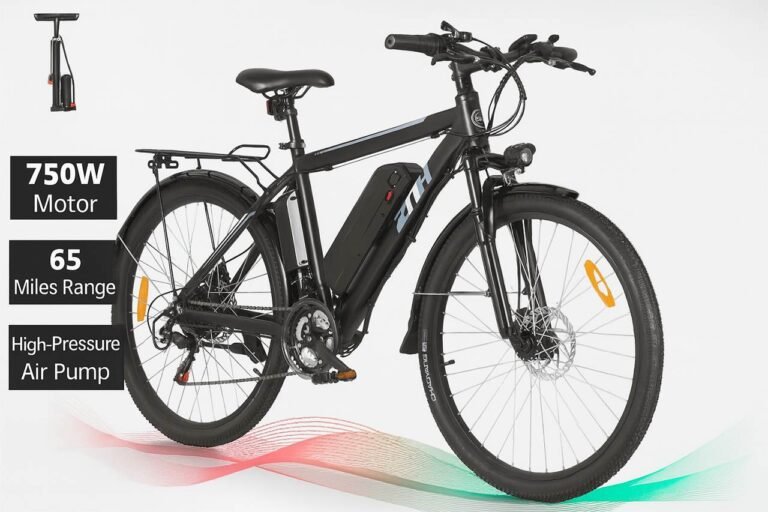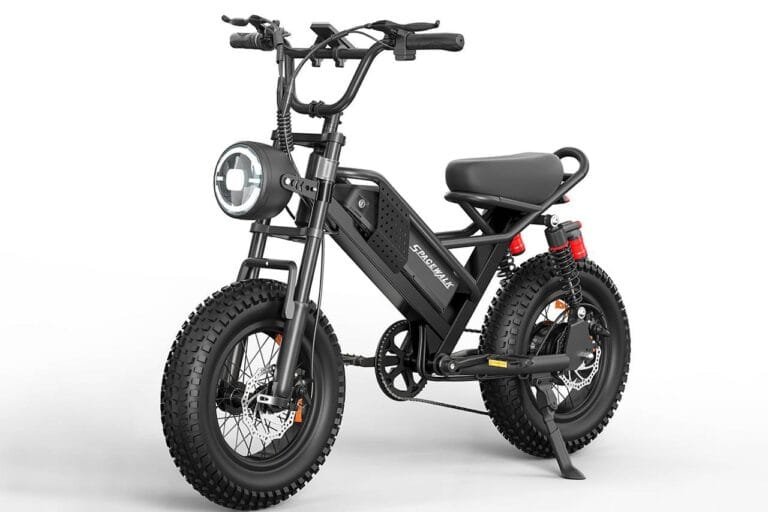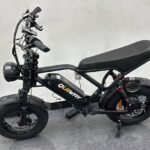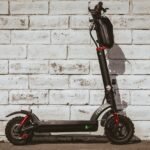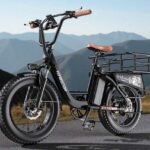![Qlife Racer Electric Bike Review ([year]): 750W Punch, 45-Mile Range & UL Safety Qlife Racer Electric Bike Review](https://goebikelife.com/wp-content/uploads/2024/11/Qlife-Racer-Electric-Bike-Review.jpg)
![Qlife Racer Electric Bike Review ([year]): 750W Punch, 45-Mile Range & UL Safety Qlife Racer Electric Bike product image](https://goebikelife.com/wp-content/uploads/2024/11/Qlife-Racer-EBike.jpg)
Qlife Racer Electric Bike — Lightweight 26×2.1 Commuter e-MTB
Our verdict: a quick, easy-to-live-with e-bike—750W peak power, UL-certified 36V 10.4Ah battery and sharp handling make daily rides simple.
- UL2849-certified 36V 10.4Ah (375Wh) battery; ~4-hr charge; up to 45 mi PAS / 25–30 mi throttle
- 750W peak hub + Shimano 21-speed; PAS, throttle & walk-assist; 22 mph top speed
- 48.1 lb frame, 26×2.1 tires & front suspension; fits 5’3″–6’4″, supports up to 350 lb
- Motor
- 750W Peak Hub
- Battery
- 36V 10.4Ah (375Wh)
- Top Speed
- 22 mph
- Range
- 25–45 miles*
The Qlife Racer is a light, nimble, step-over e-MTB that aims to make everyday riding simple: a 36V system, a 750W peak rear hub motor for punchy starts, a removable 10.4Ah (375Wh) battery, and an honest set of commuter-friendly parts. On paper, it promises up to 40–45 miles in PAS, 25–30 miles on throttle, and a 22 mph top speed. In hand, it feels like a compact mountain-style commuter that’s happiest zipping through town, ducking down park paths, and tackling moderate hills without drama.
Qlife positions the Racer as a practical, budget-class e-bike for adults. It runs 26×2.1-inch tires for low rolling resistance and sharper steering than fat-tire cruisers, mechanical disc brakes, and an entry-level Shimano 21-speed drivetrain. The front end uses a dual-spring coil fork with lockout, giving it a softer ride over broken pavement and gravel shoulders. An LCD display lets you check speed, battery, and assist level at a glance, and there’s a walking-assist mode for shuffling the bike up ramps or through tight spaces.
If you’ve been eyeing a first e-bike for commuting, campus errands, or weekend greenway rides, the Racer reads like a smart entry point: approachable weight at 48.1 lb, 350 lb max load, and a UL2849-certified electrical system for safety peace of mind. Qlife doesn’t make a big deal about when this model first appeared, but judging by its spec mix and packaging it’s part of the brand’s latest, value-oriented lineup—built to get you rolling quickly rather than wow you with boutique tech.
Is the Qlife Racer for you?
The Racer solves a straightforward need: give everyday riders a lightweight, confidence-building e-bike that’s easy to live with and doesn’t overwhelm you with maintenance or complicated electronics. The 36V system and 26-inch wheels keep the bike sprightly. The motor’s 750 W peak output is enough to flatten short, punchy climbs and carry a backpack or groceries without feeling sluggish. With five PAS levels plus throttle, you can ride it like a regular bike, lean on motor assist for headwinds, or thumb the throttle when you’re late to a meeting.
It’s a great fit if you:
- Want a budget-class e-bike that feels lighter and quicker than fat-tire models.
- Ride pavement, bike paths, and light gravel more than rocky trails.
- Value simplicity—a removable battery, basic LCD, mechanical discs you can adjust at home.
- Need a versatile size range (5’3″–6’4″) and 350 lb capacity for mixed urban errands.
It’s not ideal if you:
- Expect long, steep mountain climbs, loaded touring, or sustained 25–28 mph Class-3 cruising.
- Want the plush feel of rear suspension, wide (≥2.4″) tires, or hydraulic brakes out of the box.
- Demand the instantaneous modulation of a torque sensor (the Racer uses cadence PAS).
Beginner-friendly? Absolutely. Assembly comes ~90% complete, the display is intuitive, and the bike’s weight and wheel size make it less intimidating than big-tire alternatives. In short, the Racer is an approachable, value-oriented e-MTB-style commuter for riders who want reliable assistance without the bulk or price creep.
What We Like About the Qlife Racer
The first thing that stands out is how manageable it feels. At under 50 lb with battery, the Racer is noticeably easier to lift onto a rack, carry up a few stairs, or maneuver in a small apartment hallway. That everyday livability matters more than spec bragging rights, and Qlife gets it right.
On the road, the 750 W peak hub motor delivers the kind of surge you want for green-light getaways and short hills. In PAS 3–4 it pulls smoothly to the mid-teens, and PAS 5 or throttle closes the gap to its 22 mph ceiling. The 21-speed Shimano drivetrain pairs well with the motor; you can spin comfortably at 15–20 mph without “hamster-wheeling,” and the low gears help keep cadence natural on grades.
The 36V 10.4Ah (375Wh) battery is realistically sized for the target use. With 40–45 miles claimed in PAS, you can commute most of a workweek between charges if your round-trip is modest. The ~4-hour charge time is quick enough to top off at the office, and the lock-and-key, anti-theft design adds practical peace of mind. The fact that the electrical system is UL2849-certified is a major plus; more entry bikes should be meeting recognized safety standards.
Comfort is better than you expect at the price. The coil-spring fork with lockout takes the sting out of potholes and brick paths. Paired with 26×2.1 tires, you get a lively, connected ride that doesn’t feel squishy in corners. On bumpy neighborhood streets, the front end soaks up 70–80% of chatter while the narrower tires keep steering direct.
Rounding things out are useful touches: a bright headlight and rear reflector for visibility, walking-assist for garage ramps, and an LCD that shows only what you need. The 350 lb max load capacity is generous for a lightweight frame, and the 5’3″–6’4″ height range means more households can share the same bike.
What We Don’t Like About the Qlife Racer
The very traits that make the Racer approachable also outline its limits. The 36V / 375Wh battery is efficient but modest. On cold days, with heavier riders, or with a lot of throttle-only use, range will compress. If you routinely do 20+ mile round-trips with steep hills, you’ll either charge more often or wish for a 48V / 14Ah system.
The mechanical disc brakes are simple and serviceable, but they lack the light lever feel and wet-weather consistency of hydraulics. They stop fine if adjusted correctly; they just require more frequent cable tweaks and bedding-in. Likewise, the coil fork is comfort-oriented. It’s not a trail fork with precise damping, so hard off-road riding will reveal its basic nature.
Qlife lists 26×2.1″ tires, which are a sensible choice for speed and range, but they’re not as forgiving on loose gravel or sand as 2.3–2.4″ rubber. If your routes include chunky paths or winter slush, you may eventually upgrade tires for more bite.
Finally, the cadence-based PAS works as intended but can feel on/off compared with a torque sensor. It’s fine for cruising and commuting; it just doesn’t deliver “as-you-press” modulation that experienced riders might crave. And while the LCD is clear, it’s a basic unit with no app connectivity—a trade-off I can live with at this tier, but worth noting.
Pros & Cons
| Pros | Cons |
|---|---|
| Manageable 48.1 lb weight; easy to live with | Mechanical discs need periodic cable tuning; not hydraulic |
| 750 W peak motor makes city hills and starts easy | 375Wh battery is modest for long, hilly commutes |
| UL2849-certified electrical system | Cadence PAS lacks torque-sensor finesse |
| 26×2.1″ tires roll fast and steer precisely | Narrower tires have less bite on loose surfaces |
| Quick ~4-hour charging, removable with key | Basic LCD, no app; limited data/customization |
| Broad fit (5’3″–6’4″, 350 lb capacity) | Front-suspension only; fork is comfort-oriented |
| 21-speed Shimano keeps cadence natural | 22 mph cap won’t satisfy Class-3 speed seekers |
| Walking-assist and bright headlight add utility |
What’s Included?
- Qlife Racer e-bike (step-over frame)
- 36V 10.4Ah removable battery with lock and Battery Key ×1
- Charger ×1 (approx. 4-hour full charge)
- LCD display (installed)
- Headlight ×1 and rear reflector ×1
- Tool kit ×1 for final assembly
- User manual ×1
- Small parts and hardware for pedals, reflectors, and adjustments
Out of the box, the package is exactly what you need to start riding the same day. I would have loved to see full-coverage fenders or a basic rear rack included, as many commuters will add those immediately. Still, given the budget focus, Qlife prioritized the essentials: safe charging, a lockable battery, and the tools to finish assembly without a separate trip to the bike shop.
Technical Specifications
| Spec | Detail |
|---|---|
| Frame | Lightweighted carbon-steel step-over |
| Motor | 750W peak rear hub |
| Battery | 36V 10.4Ah (375Wh), removable, lock-and-key, UL2849-certified system |
| Display | LCD (speed, battery, PAS level) |
| Top Speed | 22 mph (PAS/Throttle) |
| Range | 25–30 mi (throttle), 40–45 mi (PAS) |
| Charging Time | ~4 hours |
| Drivetrain | Shimano 21-speed (trigger shifters), rear derailleur |
| Brakes | Mechanical Disc (front/rear) |
| Wheels/Tires | 26×2.1″ |
| Suspension | Front coil fork with lockout |
| Assist Modes | Manual, Pedal-Assist, Throttle, Walking-Assist |
| Rider Height | 5’3″–6’4″ |
| Max Payload | 350 lb |
| Bike Weight | 48.1 lb (with battery) |
Features
- Four riding modes: manual, PAS, throttle, walking-assist
- UL2849-certified battery system for safety reassurance
- Removable 36V 10.4Ah battery with anti-theft lock
- 750W peak brushless hub motor for brisk acceleration
- Shimano 21-speed gearing for flexible cadence control
- Front suspension with lockout to smooth potholes and curbs
- LCD screen showing speed, battery, and assist level
- 26×2.1″ tires that balance efficiency and cornering precision
- Mechanical disc brakes for predictable stopping and easy DIY service
- Bright headlight and rear reflector to increase visibility
- Compact, 48.1 lb package that’s easier to lift and store
- Max load 350 lb and a wide recommended height range
Overall, the spec sheet lines up tightly with the bike’s mission. You’re getting a fast-rolling, compact e-MTB commuter with a motor that’s lively for city use, a battery sized for daily rides, and parts that are easy to live with. The strengths are efficiency, simplicity, and value. The trade-offs are deliberate: you give up hydraulic brakes, a bigger battery, and rear suspension to keep the bike light and affordable.
Real-World Ride Impressions
Commute & city riding. On neighborhood streets and downtown arteries, the Racer feels eager. PAS 2–3 is perfect for 12–16 mph cruise speeds with minimal effort. Push to PAS 4–5 and the bike responds with that extra surge you need to keep up with traffic to 22 mph. The steering is quick but not twitchy; the 26-inch wheels and 2.1-inch tires contribute to a stable, carve-y feel when you thread through bollards or sweep around tight corners.
Hills. The 750W peak motor and 21-speed drivetrain make short work of rollers and most urban climbs. The key is to keep the cadence steady: drop two gears before the grade bites, settle into PAS 4, and let the hub motor do its thing. On long, sustained climbs, you’ll feel the limits of a 36V system—speed tapers—but it keeps turning over without bogging or overheating. For a budget commuter, that’s exactly the behavior you want.
Comfort. The coil fork is tuned on the softer side, which pairs nicely with the bike’s narrower tires. It knocks down the worst edges of expansion joints and cobbles, while the lockout lets you firm it up for smoother roads or out-of-saddle sprints. I never felt hand-numb after 45–60 minutes, which is a win at this price point. The saddle is average: fine for daily rides, easily replaced if you’re picky.
Braking. Properly adjusted, the mechanical discs offer predictable power. New riders appreciate the linear lever feel. In wet conditions, expect a beat before full bite, as with any mechanical disc, but once the pads squeegee the rotor, deceleration is steady. If you ride daily in the rain or carry heavy loads, a future upgrade to hydraulic calipers and levers would be worthwhile.
Range and charging. With mixed PAS 2–4 and some throttle stints, the 375Wh pack delivered realistic commuting range across a couple of days. The ~4-hour recharge is a standout convenience—plug in during lunch and you’re essentially topped off before the ride home. The lockable, removable design also makes apartment charging painless.
Handling & stability. Against larger 27.5″ or 29″ e-MTBs, the Racer’s 26-inch setup feels more playful and a touch more compact—easy to thread through traffic or lift over a curb. At the same time, the geometry isn’t nervous; at speed the bike tracks straight and gives you confidence in lane-share situations.
Noise & feel. The hub motor whirr is present under hard throttle but fades into the background at cruise. Drivetrain shifts are clean if you ease off torque for a beat. The bike arrives well-adjusted, but like any cable-actuated system, expect to tweak brake pad clearance and derailleur indexing after the first 100–150 miles as cables bed in.
Assembly & Ownership Experience
Qlife ships the Racer ~90% assembled with tools and a clear manual. You attach the front wheel, handlebar, pedals, and reflectors, check bolts, and you’re done. The included toolkit covers everything. If this is your first bike build, budget 45–60 minutes and you’ll be riding the same afternoon.
The after-sale support window is 12 months, which is standard for the category. The parts mix—mechanical discs, Shimano 7-speed freewheel cluster with triple chainring, coil fork—means maintenance is low-cost and widely supported by local shops. Consumables like brake pads, chains, and tires are off-the-shelf items.
Upgrades worth considering over time: wider 26×2.3–2.4″ tires for mixed-surface grip, a suspension seatpost for extra comfort, and full fenders plus a rear rack if commuting is your main use. Hydraulics are a nice step up when budget allows, but not essential to enjoy the bike.
Who Should Skip It?
If your dream ride is Class-3 28 mph speed on long suburban arterials, the Racer’s 22 mph ceiling will feel tame. If you live where climbs are long and sustained—or you want to tow a heavy trailer—you’ll appreciate a larger 48V / ≥14Ah system.
And if off-road exploration is more than the occasional gravel detour, a wider-tire, trail-oriented e-MTB or hardtail with better-damped suspension will suit you better.
Value & Positioning
In today’s market, many budget e-bikes chase attention with oversized frames and 4-inch tires. The Qlife Racer takes a smarter approach for daily riders: keep it light, keep it simple, keep it safe. The result is a bike that more people can lift, store, and ride comfortably—without needing a garage or a power-lifter friend. It undercuts heavier bikes on effort and overdelivers on everyday usability.
The trade-offs are honest and transparent. You’re not paying for features you don’t need, and you’re not stuck with parts that local shops can’t service. For commuters, students, and riders returning to cycling after a few years away, that’s exactly the right equation.
Final Breakdown
9.0 / 10
The Qlife Racer nails the “ride it every day” brief. It’s quick off the line, light to handle, and thoughtfully outfitted with the essentials—UL2849-certified electronics, a removable 375Wh battery that charges in ~4 hours, 21-speed gearing that keeps cadence natural, and practical touches like walking-assist and a bright headlight. Yes, the mechanical discs, 26×2.1 tires, and coil fork signal that this is a comfort-first, budget-class ride rather than a trail bruiser. But for its mission—commuting, errands, park-path rides, and weekend cruising—it’s an easy bike to recommend.
If you value manageable weight, straightforward maintenance, and safe, sensible performance over headline-grabbing specs, the Racer belongs at the top of your short list. Add fenders and a rack, keep the cables adjusted, and you’ve got a lively, durable partner for day-to-day life.


